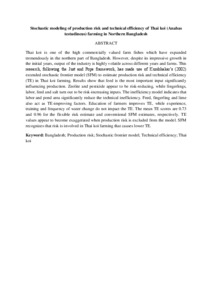Citation
Sarker, Md. Al Amin and Mohamed Arshad, Fatimah and Alam, Md. Ferdous and Mohamed, Zainal Abidin and Khan, Md. Akhtaruzzaman
(2016)
Stochastic modeling of production risk and technical efficiency of Thai koi (Anabas testudineus)farming in Northern Bangladesh.
Aquaculture Economics & Management, 20 (2).
pp. 165-184.
ISSN 1365-7305; ESSN: 1551-8663
Abstract
Thai koi is one of the high commercially valued farm fishes which have expanded tremendously in the northern part of Bangladesh. However, despite its impressive growth in the initial years, output of the industry is highly volatile across different years and farms. This research, following the Just and Pope framework, has made use of Kumbhakar’s (2002) extended stochastic frontier model (SFM) to estimate production risk and technical efficiency (TE) in Thai koi farming. Results show that feed is the most important input significantly influencing production. Zeolite and pesticide appear to be risk-reducing, while fingerlings, labor, feed and salt turn out to be risk-increasing inputs. The inefficiency model indicates that labor and pond area significantly reduce the technical inefficiency. Feed, fingerling and lime also act as TE-improving factors. Education of farmers improves TE, while experience, training and frequency of water change do not impact the TE. The mean TE scores are 0.73 and 0.96 for the flexible risk estimate and conventional SFM estimates, respectively. TE values appear to become exaggerated when production risk is excluded from the model. SFM recognizes that risk is involved in Thai koi farming that causes lower TE.
Download File
![[img]](http://psasir.upm.edu.my/53894/1.hassmallThumbnailVersion/Stochastic%20modeling%20of%20production%20risk%20and%20technical%20efficiency%20of%20Thai%20koi.pdf)  Preview |
|
Text
Stochastic modeling of production risk and technical efficiency of Thai koi.pdf
Download (74kB)
| Preview
|
|
Additional Metadata
Actions (login required)
 |
View Item |

